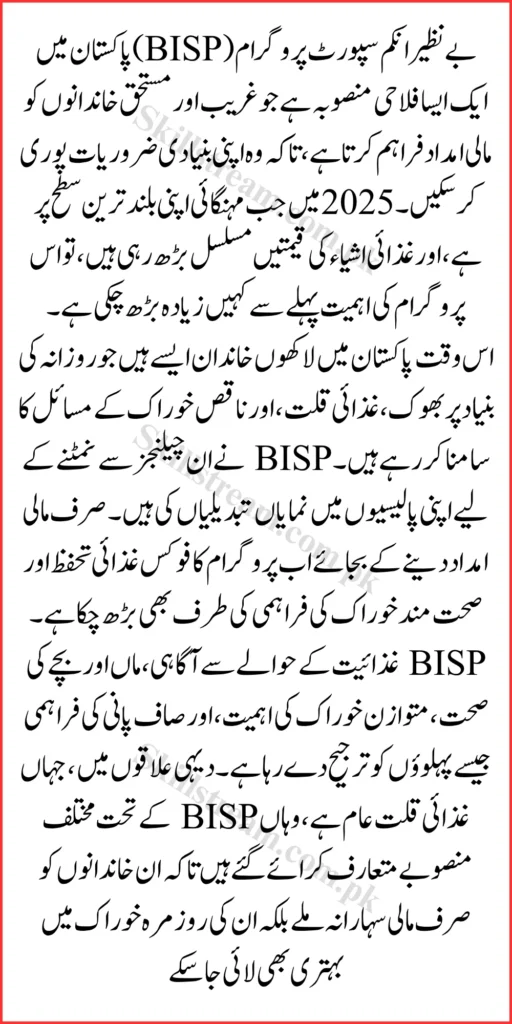As of 2025,(BISP) hunger and malnutrition remain urgent challenges in Pakistan, especially in rural and underprivileged urban areas. Rising inflation, climate shocks, and economic uncertainty have pushed millions closer to food insecurity. In this context, the Benazir Income Support Programme (BISP) stands out as a vital safety net, empowering families to access food, improve nutrition, and survive with dignity.
Initially launched as a cash assistance program for the most vulnerable households, BISP has evolved into a multifaceted tool to address poverty, hunger, and nutritional deprivation, particularly for women and children. This article takes a friendly yet informative look at how BISP is playing a frontline role in Pakistan’s fight against hunger in 2025.
Understanding Food Insecurity in Pakistan Today
Food insecurity doesn’t always mean starvation it includes situations where families can’t consistently afford nutritious, safe, and sufficient food. In Pakistan, millions face this reality daily, especially in areas affected by floods, droughts, or economic marginalization.

Some common causes of food insecurity in 2025 include:
- Rapid food price hikes due to inflation.
- Climate-related disruptions affecting agriculture.
- Job losses and underemployment in rural sectors.
- Gender-based inequality in household food distribution.
Also Read About : BISP 2025: How New Tax-Filer Rules Are Affecting Poor Families in Remote Areas of Pakistan
How BISP Is Making a Difference in Food Security
The cornerstone of BISP’s contribution to food security is its unconditional cash transfer system. Currently, eligible households receive Rs. 13,500 quarterly, a crucial sum that directly supports food purchases.
Key Ways BISP Supports Nutrition and Hunger Relief:
- Enables low-income families to buy essential groceries like wheat, rice, lentils, milk, and oil.
- Reduces reliance on loans or harmful coping strategies like skipping meals.
- Gives women financial power to prioritize their children’s nutrition.
Recent field reports from interior Sindh, Balochistan, and South Punjab show that families receiving this payments report higher food diversity and improved meal frequency, even in times of economic strain.
Also Read About : 8171 BISP Re-Registration July 2025: Full Guide for Deserving Families to Receive Rs. 13,500 Payment
Nutrition for Women and Children: A Priority Under BISP
One of the strongest features of BISP is its focus on female-headed households. This approach not only supports women financially but also ensures better decisions around food and nutrition, particularly for children under five.
Positive Impacts Observed in 2025:
- Pregnant and lactating mothers are now more likely to consume iron and protein-rich foods.
- Children from this households show better weight gain and lower dropout rates from immunization programs.
- Women report using BISP funds for clean water, milk, and basic healthcare critical components of nutritional well-being.
BISP also links with local health programs in some regions, creating a coordinated effort to monitor and improve malnutrition rates.
Also Read About : BISP July 2025 Update: 3 Types of Women Now Ineligible for Rs. 13,500 Under Benazir Kafalat
Crisis Response: BISP’s Role in Emergency Food Relief
In the wake of natural disasters such as the 2022 and 2023 floods, this has proven to be an efficient mechanism for emergency response. Its existing database and distribution system allowed for rapid delivery of additional food-related relief.
What Makes BISP Effective in Emergencies:
- A nationwide database of vulnerable families through the NSER (National Socio-Economic Registry).
- A reliable digital payment system, minimizing corruption or delays.
- Local women already engaged in the program, ensuring fast dissemination of information and support.
In 2025, BISP continues to partner with local NGOs and international organizations to expand food voucher programs and mobile food distribution efforts where needed.
Also Read About : How BISP is Transforming Food Security and Nutrition for Pakistani Families in 2025
Conclusion: From Hunger to Hope BISP’s Mission for a Nourished Nation
BISP’s role in fighting hunger in Pakistan goes far beyond handing out money. It’s about empowering women, safeguarding children’s health, and strengthening the resilience of families living on the edge. In 2025, with its widespread coverage and refined delivery mechanisms, BISP stands as one of the most effective tools in ensuring food security and nutritional justice in Pakistan.
To build on its success, continued efforts are needed in digital inclusion, nutritional education, and better linkages with healthcare and agriculture sectors. But one thing is clear BISP is a cornerstone of hope for a food-secure Pakistan.
FAQs
1. Does BISP only provide financial help, or does it include food distribution?
While BISP’s main feature is cash support, in emergencies or disaster-affected regions, it collaborates with partners to provide food aid and nutrition supplements.
2. How does BISP improve child nutrition specifically?
Women receiving BISP funds often use them to buy milk, fruits, and nutritious food for their children, which directly improves child growth and health.
3. Is BISP linked with any health programs for malnutrition?
In some provinces, BISP works alongside local health departments to monitor child weight, provide supplements, and encourage vaccinations.
4. How can a family use BISP funds most effectively for nutrition?
Prioritize protein sources (like lentils, eggs, milk), vegetables, and clean drinking water. Avoid spending on non-essential processed foods.
5. Can BISP help during a natural disaster or food shortage?
Yes, during emergencies, BISP can disburse additional funds or partner with relief agencies to provide direct food aid to affected areas.
Also Read About : How to Apply for the 8171 Ehsaas Program from Mobile or Home in 2025 – A Simple Step-by-Step

